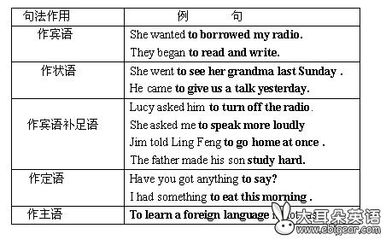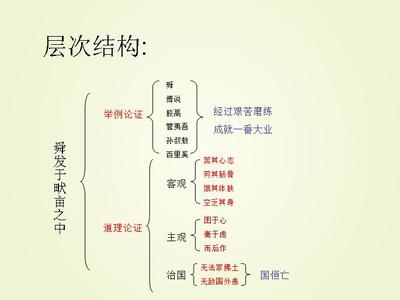动词不定式用法
不定式由“to +动词原形”构成,其否定形式是“not to+动词原形”。不定式可以带宾语或状语构成不定式短语,没有人称和数的变化,但有时态和语态的变化。不定式可作主语、宾语、状语、表语和定语,但不能单独作谓语。不定式的逻辑主语有时有“for+ 名词或代词宾格”构成。
1.不定式的用法
1)作主语。不定式短语作主语时,往往放在谓语之后,用it作形式宾语。如:
To see is to believe.
It is right to give upsmoking.
2)作宾语。不定式短语作宾语时,如果还带有宾语补足语,往往把不定式宾语放在宾语补足语之后,而用it作形式宾语。如:
He wanted to go.
I find it interesting to studyhistory.
有些动词后只能用动词不定式作宾语,必须跟动名词。如:decide,plan,desire,expect,hope, wish,pretend,promise,refuse,afford,agree,ask,fail,tend,pretend,manage
3)作宾语补足语。如:
He asked me to do the work withhim.
注意:在feel,hear,notice,observe,see,watch,have,let,make等词后的补足语中,不定式不带to。但这些句子如果变成被动结构时,就必须带to。如:
I often hear him sing thesong.
He is often heard to sing thesong.
注意:动词不定式在介词but后面时,如果介词之前有行为动词do的各种形式,那么,这些介词后的不定式不带to,否则要带to。另外,在can’tchoose but和can’t helpbut等后面的不定式也省略to。如:
She could do nothing but cry.
I have no choice but to go.
4)作定语。如:
I have some books for you toread.
①作定语的不定式如果是不及物动词,或者不定式所修饰的名词或代词是不定式动作的地点、工具等,不定式后面须有相应的介词。如:
He is looking for a room to livein.
There is nothing to worryabout.
Please give me a knife to cutwith.
但是,不定式所修饰的名词如果是time,place或way,不定式后面的介词习惯上省去。如:
He had not money and no place tolive.
②当作定语的不定式所修饰的名词或代词是不定式动作的承受者时,不定式既可以用主动语态,也可用被动语态,但其含义有所不同。试比较:
Have you anything to send ?
(你有什么东西要寄吗?——不定式tosend的动作执行者是“你”)
Have you anything to be seat.
[你有什么要(我或别人)寄的东西吗?——不定式tobe sent的动作执行者是“我”或“别人”]
5)作状语,表示目的、原因、结果或条件。如:
I came here to see you.(目的)
We were very excited to hear thenews. (原因)
He hurried to the school to findnobody there. (结果)
To look at him,you would like him. (条件)
目的状语还可以用in orderto或so asto来表示但so asto不能置于句首。如:
In order to pass theexam, he worked very hard.
We ran all the way so as not to belate.
不定式也可以在作表语用的形容词后面作状语。如:
I am very glad to hear it.
The question is difficult toanswer.
“too + 形容词或副词+不定式”作状语。如:
He is too old to do that.
另外,句子中有enough这个词时,常用不定式作状语。例如:
The room is big enough to holdus.
6)作表语。如:
My job is to help thepatient.
7)作独立成分。如:
To tell the truth, Idon’t agree with you.
8)不定式与疑问词who,which,when,where,how,what等连用,在句中起名词作用,可充当主语、表语、宾语等。如:
He didn’t know what tosay. (宾语)
How to solve the problem is veryimportant. (主语)
注意:在与why连用时,只用于why或whynot开头的简短疑问句中,后面紧跟的动词不定式不带to。例如:
Why not have a rest ?
9)不定式在句中用主动式还是被动式,多数情况下是容易判断的,但有时的确比较复杂,请注意以下几点:
①不定式修饰的名词或代词和不定式逻辑上构成主谓关系时,不定式往往用主动形式。如:
Have you got a key to unlock the door?
(A key unlocks the door. )
②不定式和它前面被修饰的名词或代词构成逻辑上的动宾关系,又和该句主语构成逻辑上的主谓关系时,不定式常用主动形式。
I have got a letter towrite. (I write letter.)
He needs a room to live in.(He lives in a room.)
I know what to do.(I do what. )
但这句如改为下列形式,不定式就得用被动形式:I know what is to be done.
这是因为what is to bedone是宾语从句,从句中的主语what是动词do的动作对象。
③不定式作表语形容词的状语,和句中主语构成逻辑上的动宾关系时,不定式多用主动形式,这是因为人们往往认为形容词后省去了forsb. 。如:
He is hard to talk to.(to talk to him)
The book is difficult tounderstand. (to understand thebook)
④在therebe结构中,当说话人考虑的是必须有人去完成某件事时,不定式用主动形式;如果说话 人强调的事情本身必须完成,则用被动形式。
There is a lot of work todo. (Somebody has to do thework. )
There is a lot of work to bedone. (The work has to bedone. )
请注意下面两个句子的含义是不同的:
There is nothing to do.(无事可做,感到十分乏味。)
There is nothing to bedone. (某东西坏了,无法使之恢复正常。)
2.不定式的时态
1)不定式的一般形式所表示的动作,通常与谓语的动作(状态)同时(或几乎同时)发生,或是在它之后发生。例如:
I saw him go out.
2)如果谓语表示的动作(情况)发生时,不定式表示的动作正在进行,这时不定式就要用进行式。例如:

He pretended to be reading a book whenshe went in.
3)如果不定式的动作发生在谓语动词之前,就要用完成式。例如:
I’m sorry to have kept youwaiting.
3.不定式的语态
当不定式逻辑上的主语是这个不定式所表示的动作的承受者时,不定式一般要用被动形式。如:
He asked to besent to work in the countryside.
It is possible for our hopes to berealized.
4.不定式符号to的保留问题
有时为了避免重复,可以用to来代替前面的不定式,这种情况常出现下列动词后:expect,prefer,care,mean,forget,want,wish,hope,try以及beglad/happy等后。
如果在省略的不定式结构中含有be,have,havebeen,这些词要保留。如:
—Are you on holidays?
—No, but I’dlike to be.
—I didn’t tell him thenews.
—Oh, you oughtto have.
 爱华网
爱华网



